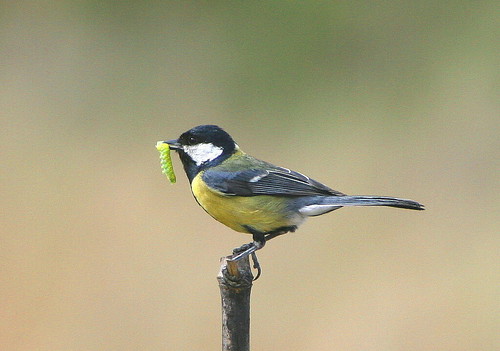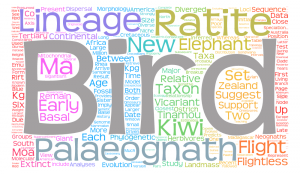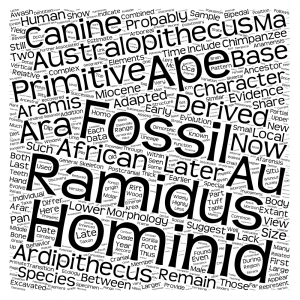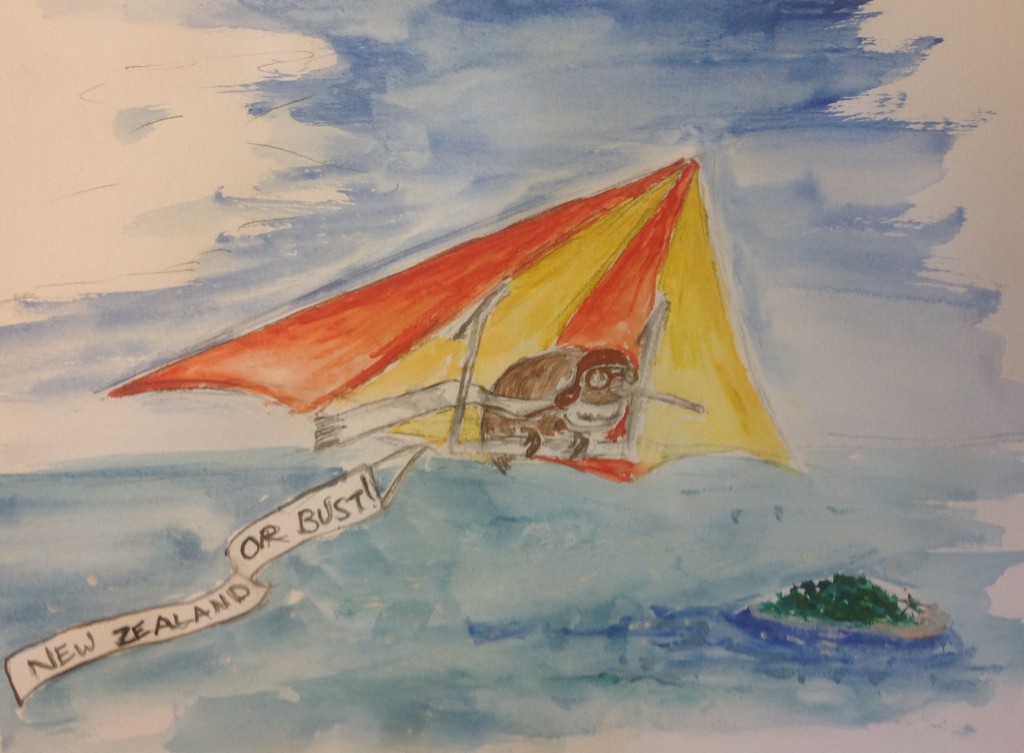At some point in elementary school– maybe third or fifth grade– your teacher likely pulled out a chart showing maps of the world throughout geological history, showing all the continents cozily squished together for a while as Pangea before they all started wandering off on their own. You probably traced the routes they took, noticed how South America and Africa seemed to fit together like puzzle pieces, and probably sat through an explanation involving dinosaur and fern fossils found throughout the Southern Hemisphere and an unlucky German weatherman who was unfortunate enough to be the first person to seriously suggest that the continents moved around throughout time. At some point, if your class was anything like my fifth grade science class, the teacher probably got into more detail about what all this continental rambling about meant for the plants and animals still around today- that all the fantastic and weird marsupials of Australia and the lemurs of Madagascar came to be because those two landmasses left the Gondwanan party early, before the more typical mammals took over, and that certain animals were found on all of the different continents of the Southern Hemisphere, distant cousins who all rode the bits and pieces of the former southern supercontinent to their current positions. At this point, in all likelihood, somebody brought up ratites. Continue reading “The Case of the Flying Kiwi”
Ardipithecus ramidus; four feet to two
In the evolution of humans, there was a point in time when our ancestors did not walk on two feet, but instead moved around on four. As the ancestors of humans evolved, they eventually reached a point where the transition to two feet began to occur. For a time, the fossils found detailing such a transition were of Australopithecus, a bipedal creature which seemed to sprout up in our evolutionary history 3.7 million years ago (1). Australopithecus had multiple novel adaptations associated with bipedalism, causing many scientists to believe Australopithecus to be the result of a sudden evolution of bipedalism in the ancestors of humans. At the same time, other scientists believe that bipedalism was unlikely to have suddenly shown up in Australopithecus with fully formed adaptations. Instead, they believed it was the result of a more gradual process, with multiple distinct ancestors in-between. Unfortunately for scientists who believed the gradual step process, there were no fossils to support such a hypothesis until the discovery of a new species known as Ardipithecus ramidus, in November 1994, whose skeletons were discovered in Ethiopia(2). Continue reading “Ardipithecus ramidus; four feet to two”
Jumping Genes and the Evolution of Pregnancy
The human genome is made up of over three billion base pairs, the building blocks of DNA, but only a small part of that is actually protein coding DNA. Transposable elements (TEs) are a type of non-coding DNA that makes up approximately half of the human genome, and since their discovery in the 1940s, they have carried a bad reputation. Often referred to as junk DNA or parasitic genes, TEs are a type of mobile genetic element capable of moving around or “jumping’ within the genome. There are two main types of TEs: retrotransposons, which copy themselves and then reinsert the copies back into the genome and DNA transposons, which cut themselves out of the genome and move to a different site (Figure 1). When TEs move around, they sometimes land in the middle of a gene or even another TE, which is often detrimental to the function of that gene or TE. The function and potential benefits of TEs have not always been clear, but research has slowly started to unravel their mysteries. A group of scientists at Yale, lead by Gunter Wagner, recently found that TEs may have been responsible for the evolution of pregnancy in mammals.

Continue reading “Jumping Genes and the Evolution of Pregnancy”
Great Tits and Climate Change: An Experiment to Transform Current Prediction Models

Background:
Timing is everything for bringing new life into the natural world. Every year, species such as the great tit (Parus major), one of the many song birds found on the British Isles, rely on abundant food to be able to provide enough nutrients for their growing young. The presence of this food is the result of a large cascade–like a line of dominos–that begin with the smallest of microorganisms responding to environmental factors such as temperature and salt concentration. If the timing of one of these falling dominoes is slightly off, many organisms further down the line suffer and may be unable to find food at the most critical times of early offspring growth. Two particular organisms that share the same line of dominoes as the great tit are the pendunculate oak (Quercus robur) and the various caterpillars which feed on the oak’s leaves. [3] Continue reading “Great Tits and Climate Change: An Experiment to Transform Current Prediction Models”
Inheritance of personality: How much do genes matter?

Personality. All individuals have one. Yet, what actually contributes to individuality? Although seemingly simple, personality frustrates evolutionary biologists due to its complex and convoluted nature. It is well established that personality can have important evolutionary implications (1, 2, 3, 4, 5), but determining a method to test the genetic underpinnings of personality has proven difficult. Continue reading “Inheritance of personality: How much do genes matter?”
Going gaga for ferns!

Background
Hybridization has been shown to play a critical role in the evolution of plants (Rieseberg and Wendel 1993) and molecular studies have allowed scientists to re-evaluate taxonomy through multiple methods besides just morphological characteristics (Li et al. 2012). However, some ferns, such as the cheilanthoid ferns in the family Pteridaceae, had not been re-classified as of 2012 even though they were known to be non-monophyletic (that they didn’t all share a single common ancestor). Li et al. (2012) were particularly interested in a group of about twenty cheilanthoid ferns referred to as the “Cheilanthes marginata group,” which are found in arid habitats ranging from Arizona and Texas all the way to Bolivia. They hoped to distinguish this group from its most closely related fern relatives and revise the taxonomy based on the number of chromosomes (an organism’s condensed DNA) and genetic relatedness. Continue reading “Going gaga for ferns!”
EmANTcipation: When captured ants rise against their captors
Throughout history, humans have had a fascination with ants, featuring them in fables and folklore (See Aesop’s “The Ant and the Grasshopper”or Greek mythological Myrmidons). Their social and industrious nature make it easy to see them as human-like, and one cannot help but marvel at adaptations such as underground fungus gardens, herding and tending of aphids, burial of their dead, and their ability to work as a group to accomplish a common goal, to name a few. While most people view ants as kitchen or sidewalk nuisances, researchers who study ants are continuously revealing new and exciting complexities about ant behavior.
Slave-making (also called slave-raiding) in ants occurs when ants leave their nest, enter the nest of another species of ant, steal the developing larvae and/or pupae, bring them back to their own nest, and then rear the captured young into adult workers. Slave-making is a type of social parasitism, meaning that the slave-making ants are benefiting at the expense of the host, or captured, species of ant. This relationship can either be facultative, meaning that the slave-making ant can survive without taking brood from another colony (though they may not be as productive without slave-making), or the relationship can be obligate, meaning that the slave-making ants are unable to survive, usually because they cannot eat or care for their own young, without help from the host. Continue reading “EmANTcipation: When captured ants rise against their captors”
Spring 2015
 Welcome to the first semester of posts. We are the students of Principles of Evolution, a course in the Biology and Wildlife Department at the University of Alaska Fairbanks. Each year we will highlight research on evolutionary biology. In the following weeks, we’ll see seven different research highlights of different papers from recent years.
Welcome to the first semester of posts. We are the students of Principles of Evolution, a course in the Biology and Wildlife Department at the University of Alaska Fairbanks. Each year we will highlight research on evolutionary biology. In the following weeks, we’ll see seven different research highlights of different papers from recent years.



